Review: Pantech Pocket for AT&T
Nov 29, 2011, 1:34 PM by Eric M. Zeman
Pantech's latest handset for AT&T is the unconventional Pocket, which has an extra-wide display. The question is, does the Pocket put the big screen to good use? Phone Scoop finds out.
Form
Is It Your Type?
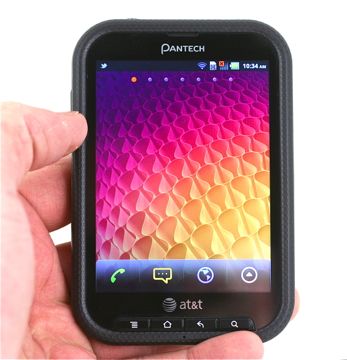
If you're tired of run-of-the-mill Android smartphones and are looking for something that's a little bit different, Pantech offers the Pocket for your consideration. This extra-wide smartphone packs a basic set of smartphone tools, but still manages to find a way to stand out.
Body
I won't deny that the Pantech Pocket is somewhat odd in appearance. Thanks to its 4:3 aspect ratio display, the Pocket is a lot wider than your typical slab-style Android smartphone. For example, it is 3.1 inches wide, where most other Android smartphones are closer to 2.5 inches wide. That extra 0.6 inches may not sound like a whole lot, but trust us when we say you'll notice the difference. On the flip side, it is shorter than many competing models. The shorter-but-wider dimensions give it a unique, squat look.
For materials, Pantech stuck to plastic and glass (no metal in the external shell here.) It feels mostly good to use. I like that the Pocket has a texturized — yet soft-touch — material covering the back surface and side edges. It gives the Pocket a lot of extra grip. This textured material wraps around to the front of the Pocket and provides a lip that encircles the display. The lip ensures that if the Pocket is placed screen-down on a flat surface, the screen won't be scratched by said flat surface.
In the hand, the Pocket feels kind of ridiculous. Unless you're Kareem Abdul Jabbar, there's no way you're wrapping your hand all the way around it; it's just too wide. The depth of the handset measures 11.7mm, which is a bit more than I'd like, but not egregiously thick. It still manages to fit well into a pocket, but man, you know that it is there, thanks to that wide shape.
Aside from the display, the only buttons on the front face of the Pocket are the four Android controls. Pantech opted for physical keys rather than capacitive. They are placed against the bottom lip. I found them easy to find and use, and all four buttons had good travel and feedback.
The volume toggle is on the left edge of the device. It's smooth compared to the texture of the edge itself, and stands out nicely from the side of the phone. Travel and feed back are excellent, making the volume toggle a very functional button. The microUSB port is on the right edge of the phone. Sadly, there is no dedicated camera button.
The power / screen lock button is on the top of the phone. Instead of opting for a button resembling a thin dash running parallel to the edge (like most other Android handsets), Pantech opted to go with a round button. It is perfect. It may be small, but it sticks out from the edge just the right amount, and has excellent travel and feed back. I really like this little button. Also on top is the 3.5mm headset jack.
The battery cover can be pried off with the help of your thumbnail. It is worth noting that the Pantech Pocket does not use a regular SIM card. Instead, it uses a micro SIM card, similar to the one used in the Apple iPhone 4/4S. That means you won't be able to pull the SIM out and use it in your old AT&T or T-Mobile phone. You have to remove the battery to get at the micro SIM card, but not the microSD card, which can be swapped without turning off the phone.
The Three S's
Screen
The Pocket has a 4-inch display with 600 x 800 pixels. That's 120 pixels wider than a common 480 x 800 display. You can think of those extra pixels as just annexing some screen real estate on the side, or you can think of it as a sharper display with a different shape. Either way, the display looks good; it has sharp graphics and text, clean lines, and no visible pixels anywhere. What disappoints me about the display is the brightness, which just isn't that good. It works fine indoors, but outside it is very hard to see at all. It lacks the vivid "pow" that Samsung's Super AMOLED displays have, but it gets the job done.
Signal
Tested around the metro NYC area, the Pocket performed well. It regularly showed three or four bars of coverage and only dropped down to one bar under the worst network conditions. The Pocket's signal indicator mirrored that of other AT&T devices used in the same spot. The Pocket never lost hold of AT&T's network during my tests. I was able to connect all voice calls on the first dial, though the Pocket dropped two calls while I was using it (albeit traveling in a car). Data sessions were consistent, but never very fast. The browser definitely stalled when the network conditions were poor.
Sound
The quality of voice calls was not that great in my experience. There's a bit of background hiss that never goes away, and I had a lot of conversations break up and fade in/fade out. The earpiece is not quite as powerful as I'd like it to be. It's fine for conversations at home, but anywhere outside or where other people are convening, it's nearly impossible to hear your callers. The speakerphone had the same quality problems, and was also too quiet. I struggled to hear some calls even at home. Ringers and alerts were OK, but not great. I missed a few calls when I was in another room, even with the volume set to the max. The vibrate alert is good and strong.
Battery
The Pocket performs about as well as most other Android phones when it comes to battery life. You'll easily get a full day out of it, and perhaps a portion of a second, but not two full days. Sporadic users who go to lengths to minimize power drain may be able to stretch it to dinner the second day, but most users are still going to want to charge every night.
Typing
As Rich and I noted during our initial hands-on with the Pocket back in October, the Pocket is an excellent device on which to type messages.
The added screen real estate and 4:3 aspect ratio give the on-screen keyboard plenty of breathing room, especially if the phone is held sideways. The enlarged keyboard software makes for easier, faster typing that is more accurate.
The Pocket ships with the Swype software keyboard, as well, but I'd dare say you won't need to use it. The Pocket is easily the best touch screen phone I've used for pecking out text messages and emails.
While it may be odd to you that we're earmarking this as a selling point for the Pocket, remember that low-cost Android phones are replacing low-cost quick messaging devices. The Pocket's on-screen keyboard is good enough that you can skip a device with a physical QWERTY keyboard. It's food for thought, is all we're saying.
Basics
Menus
The Pantech Pocket runs Android 2.3.4 Gingerbread that's been customized just a bit by Pantech with some home screen widgets and other minor touch-ups.
The lock screen is perhaps the most useful of the customizations. There's a large ring in the center of the lock screen and it is surrounded by six apps. Drag the app you want into the circle and you go directly there. Out of the box, those apps are the phone, SMS/MMS, email, browser, main menu, and the media player. Yes, Pantech forgot to include one for the camera, d'oh! Lock screen shortcuts like these are a great addition to recent Android devices, and the Pocket's is a good implementation. Pantech told Phone Scoop that users will eventually be able to customize these shortcuts, but for the moment, they can't be changed.
The Pocket has seven home screens that can be customized with widgets, shortcuts, and apps. There is a dock at the bottom that provides access to the phone, messaging, browser, and main menu. This dock visible across all the home screens.
The main menu is a grid of apps, 16 of which are visible at any one time. Slide the apps to the left to access more. The apps slide across in groups, meaning there are four distinct pages of apps (the number of pages goes up if you download more). You can set the main menu to display apps in an alpha-based grid, user-defined grid, or in list form. One neat feature: the Pocket allows users to set a separate and unique wallpaper for the main menu view. There are a bunch preloaded, and they have a whimsical, cartoonish flair to them.
All other aspects of the Pocket's menus behave as you'd expect on a Gingerbread phone.
A note on performance. The Pocket can be sluggish. With a single-core 1GHz processor, it feels a bit underpowered. Apps that appear to be most affected by the processor are the camera, browser, and Google Maps.
We've asked Pantech if the Pocket will be updated to Android 4.0 Ice Cream Sandwich, but we have yet to hear back from them. Now that Android 4.0 is on the cusp of availability, it should probably play a role in your decision-making when it come to picking a new phone.
Calls/Contacts
Calls
Aside from the lock screen shortcut that takes you directly to the call log, there's little setting the Pocket apart from other Android handsets when it comes to the phone app. It looks a little different thanks to the judicious use of green and blue accents, but the function of the phone dialer and recent calls is exactly the same as on any stock Android handset. A tab of choices runs across the top of the screen, permitting access to favorites, the contacts app, etc.
Contacts
The contact application, too, is that of stock Android. The one thing setting it apart is a really useful home screen widget. The widget lets create a miniature list contact list that is accessible from the home page. It holds at least ten people, and includes their thumbnail photo. Press any of the faces, and a second screen appears with info such as the last call, email, and SMS received by that person, as well as links to the phone app, full contact app, and so on. It's a neat widget.
Messaging
The Pocket covers all of the messaging basics. It runs the stock messaging (SMS), email, Gmail, and GTalk apps. All of them work well, though they don't present any new features.
There's no support for third-party instant messaging, so you'll have to scout through the Android Market to find the right IM apps.
The Pocket comes with both the full Facebook and Twitter apps, as well as some handy widgets for both.
Extras
Media
Music
The Pocket has the same, solid music app that was on the Crossover. Rather than the bland tabs across the top of the screen to sort through songs, albums, artists, and playlists, the Pocket has a drop-down menu to access those things. It's not radically different, but enough so to give the Pocket its own identity and feel. Playback is the same as most other Android handsets with the requisite controls for play/pause, skip forward and back, shuffle, loop, and so on.
In terms of extras, the Pocket has an extended list of equalizer options for shaping the sound it produces. There are a number of 3D sound effect that can be applied, such as "NASH", "Live", "Wide", "MEX", and Virtual Sound 7.1 Channel (really, on a phone?). The Pocket also has a full equalizer with 14 oddly-named presets (Strong, Fresh, Dark, Hard, Shiny, Dry, Stable, Gloomy, etc.) and two different user configurable options.
There are no other music apps pre-installed, so you'll have to go fish in the Android Market for the likes of Slacker and Pandora.
Video
The Pocket has a few options for video playback. First, it has the stock YouTube application. Also, the stock gallery application serves to play back locally-stored video content, such as recordings captured with the phone or side-loaded from a PC. It also has AT&T's Mobile TV application, which offers snack-sized video content streamed over the network, although it requires that you pony up for a subscription.
As far as purchasing any type of content from the handset goes, there is a movie rental service called "Movies" that is powered by mobiTV. It's not bad, but rental prices were a bit steep at $4.99. Other rental services keep prices between $1.99 and $3.99.
Camera
Camera
The Pocket has a 5 megapxiel camera. The software that controls it is decent, but stripped of some features typically found on more high-end devices. The camera will open if you press the software button on the home screen, but I gotta call Pantech out for the lack of dedicated camera button and the misstep of leaving a camera shortcut off the home screen.
Once open, the viewfinder is mostly reserved for viewing your subject. Only a small sliver on the side is reserved for some basic controls (software shutter button, switch to video camera). If you tap the screen once, another control panel will appear on the other side of the screen. This allows users to adjust the shooting mode, white balance, exposure, and a few other settings before firing off some shots.
The Pocket can be set to auto-focus, fixed-focus, or macro focus (for close-ups) modes. When in auto-focus mode (which I highly recommend you use), the Pocket will focus on whatever is in the center of the screen. There is no touch-to-focus. Press the on-screen shutter button and the Pocket takes about a second or two to focus, and then another second to process the shot and get you to a review screen. From there, you have the typical options for sharing or jumping back to the camera application. It's way, way too slow.
Gallery
The Pocket uses the stock Android 2.3 gallery application. You can open it either from the camera app or the main menu. It syncs with your Google Picasa account (if you have one) and sorts photo albums based on date and location. They float in a 3D-esque space.
With an album open, photos and videos are intermingled based on when they were captured. You can navigate through the album quickly to drill down to the photos you want to see/interact with.
Sharing options for photos are ridiculous. Think of a service or social network, and you can push the photo to it. Editing features, however, are limited to crop and rotate left/right.
Photos/Video
Photos
I had high hopes for the Pocket's camera, but they were dashed a bit. Focus was inconsistent and often bad, but the big problem is exposure. The Pocket's camera had real problems balancing light. Bright lights turned into blow-out smears, dark regions were nothing but black pits with zero detail, and there was never any middle ground. Worse, there's way more grain in images than I expect to see from a 5 megapixel camera. They're just not good pictures.
Sure, you'll get lucky every now and then, but I don't want to get lucky with a camera. I want my camera to deliver good, usable results every time. The Pocket doesn't provide that.
Video
The Pocket can shoot video at 720p HD resolution, and in comparison it does better than the still images. Though it is a bit blockier than I think 720p HD video should be, motion appeared to be smooth, and the video camera did a better job of getting exposure correct. You still probably aren't going to capture any winning YouTube videos, but at least you'll be able to record events.
Browse/Customize
Browser
The Pocket has the stock Android browser on board. It's still a great browser when it comes to handling web pages and web content. Unfortunately browsing speeds were not fantastic with the Pocket. Data sessions were regularly slow, full of stalls, and relied on good coverage.
Customize
The Pocket offers the basic set of customization tools that are found on any Android phone. Ringtones, alerts, wallpapers, etc., are all easily changed and adjusted. The home screen panels can be stuffed with apps, shortcuts, and widgets. Let's not forget that you can rearrange the main menu, too.
It also has a handful of themes. The themes each have different wallpapers and shortcuts installed on the home screen panels depending on what activity you're prioritizing. For example, in the work theme email, calendar, and the phone are prioritized. The social theme dials in all the social networking and messaging apps. You get the idea. Each of these can be adjusted and saved, and there is a fully blank theme that can be completely customized the way you want it. The themes only change the home screen layouts, they don't alter the basic look or functionality of the user interface.
Extras
Apps
AT&T has loaded more than its fair share of junk apps onto the Pocket. Of course, the usual branded stuff is in board such as AT&T Code Scanner, FamilyMap, Navigator, LiveTV, myAT&T, and the Yellow Pages app (why, AT&T, why?!?). Some of these can be axed, some cannot.
Bluetooth
The Pocket supports mono and stereo headsets, phone book access, and object push with its Bluetooth 2.1+EDR radio. I had no trouble pairing with headsets and other phones. Sound quality of calls through the headsets was not very good. In fact, I had to disconnect the Pocket from my car, as calls sent to the car's speakers were atrocious. Stereo music sent to a set of Bluetooth speakers sounded pretty good, though.
Clock
The Pocket has its own version of the Android lock screen clock. The time is displayed in white digits in the center of the lock screen circle. Since the lock screen is a bit busy, it can sometimes be hard to discern the time in a quick glance.
GPS
The Pocket has Google Maps in addition to a flotilla of AT&T navigation/location services installed. The AT&T services, such as Navigation and FamilyMaps work well, though they cost an extra few bucks each month. Google Maps is a good, free substitute. I found the GPS radio to be quick and accurate, but Google Maps was very slow to to refresh thanks to the Pocket's sluggish data performance.
Wrap-Up
In sum, I like the hardware of the Pocket a lot. While it may look unconventional, the materials and build of the phone are spot-on, and the Pocket's odd shape certainly give it a personality all its own. That's what makes it a shame that the Pocket's performance is so uneven.
The screen has good resolution and clarity, but lacks brightness. The Pocket connects to AT&T's network easily, but voice calls don't sound good. The menus work well, and the extra screen real estate make for an excellent typing experience, but there are no stand-out features or programs that make use of the Pocket's screen.
The real killer for me, however is the camera. The Pocket's 5 megapixel shooter has to be the worst I've used on a phone. If you want a solid imaging device, look elsewhere. If you don't care much about pictures but want a fast typing device, then maybe the trade-off is worth it.
I'd recommend the Pocket to customers who primarily use their device for messaging and want to move away from a keyboard-equipped device, but most others can find a good deal on a better phone from AT&T right now. The Pantech Pocket is no rocket in your pocket, and I'm not sure you're going to be happy to use it.

Comments
No messages


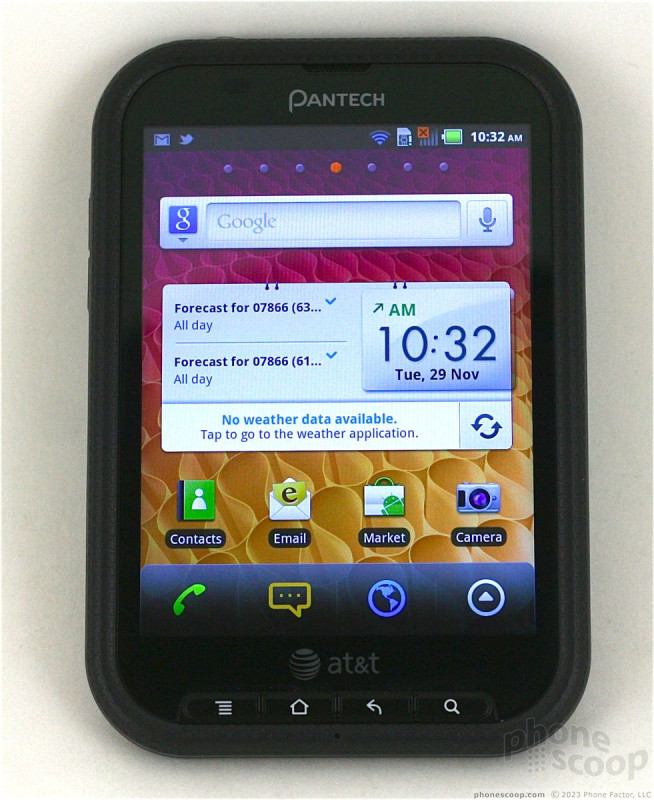




























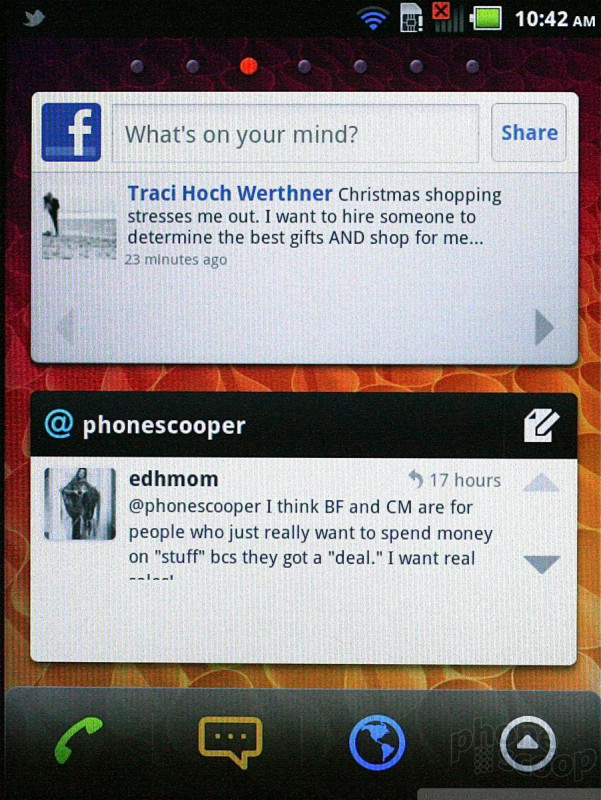



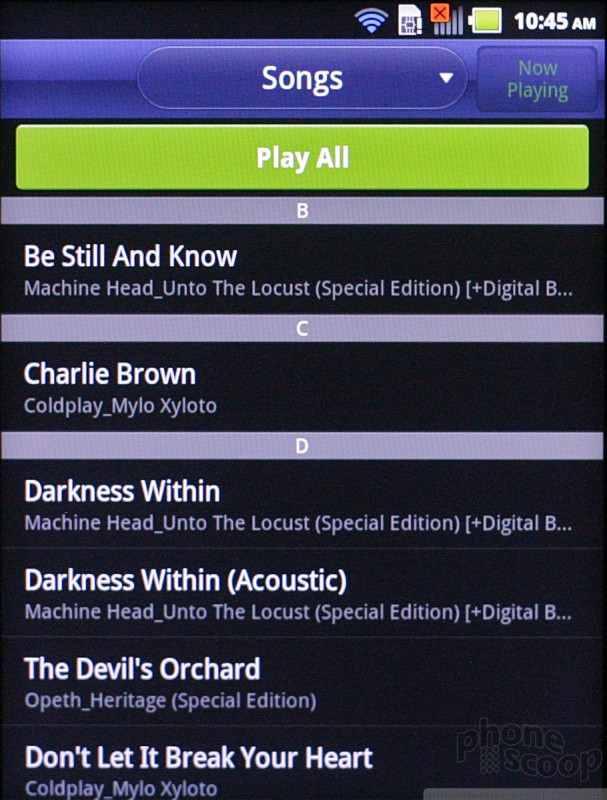



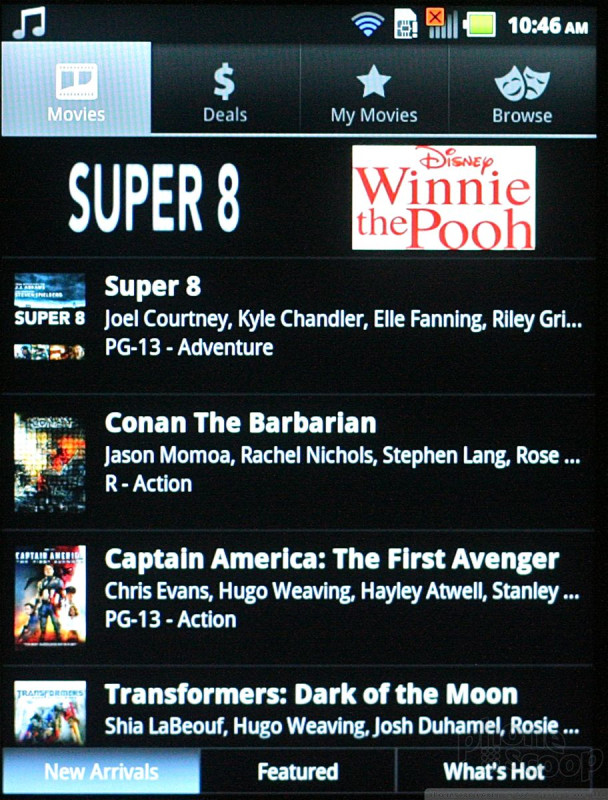



































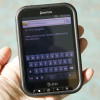 Hands-On: Pantech Pocket for AT&T
Hands-On: Pantech Pocket for AT&T
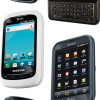 AT&T Announces Five New Android Smartphones
AT&T Announces Five New Android Smartphones
 Pantech Pocket
Pantech Pocket



